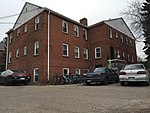East Lansing, Michigan
1847 establishments in MichiganCities in Clinton County, MichiganCities in Ingham County, MichiganEast Lansing, MichiganLansing–East Lansing metropolitan area ... and 3 more
Michigan State UniversityPopulated places established in 1847Use mdy dates from January 2022

East Lansing is a city in the U.S. state of Michigan. Most of the city lies within Ingham County with a smaller portion extending north into Clinton County. At the 2020 Census the population was 47,741. Located directly east of the state capital of Lansing, East Lansing is well-known as the home of Michigan State University. The city is part of the Lansing–East Lansing metropolitan area.
Excerpt from the Wikipedia article East Lansing, Michigan (License: CC BY-SA 3.0, Authors, Images).East Lansing, Michigan
Abbot Road, East Lansing
Geographical coordinates (GPS) Address Nearby Places Show on map
Geographical coordinates (GPS)
| Latitude | Longitude |
|---|---|
| N 42.748055555556 ° | E -84.483611111111 ° |
Address
Abbot Road
48823 East Lansing
Michigan, United States
Open on Google Maps








